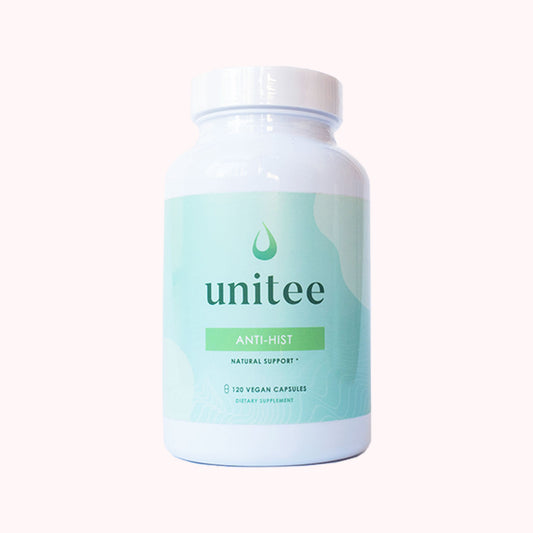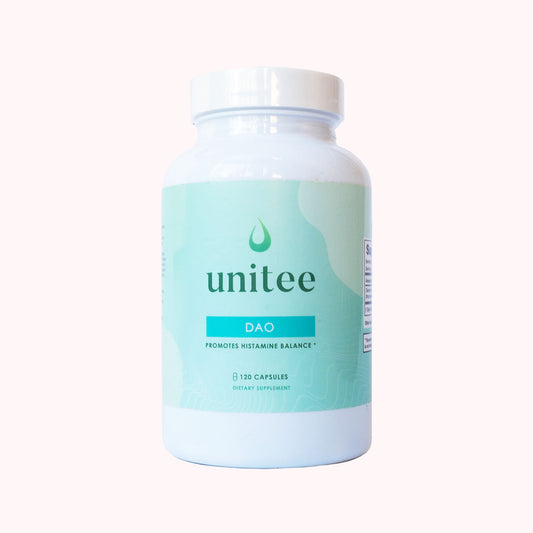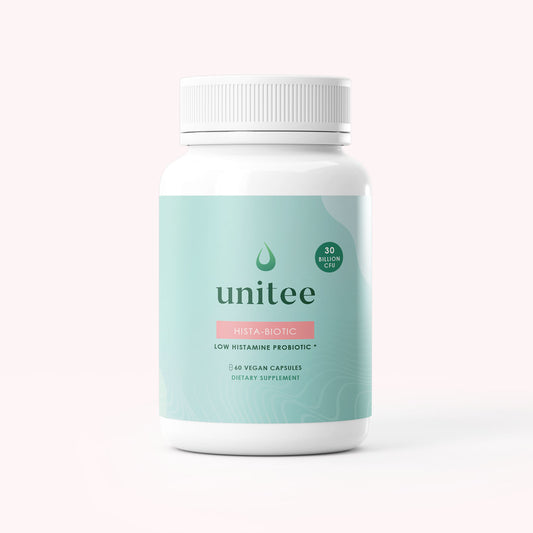So you’re scanning through the ingredients on your favorite healthy baked product you’ve always enjoyed… and you’re sure it’s safe. After all, there’s no gluten, dairy or preservatives listed.
Why then is it causing you to feel bloated, gassy and in pain?
Well, even though it might not appear to have any bothersome ingredients, there may be one to look out for: xanthan gum.
It’s often listed as an ingredient containing no histamine. But that’s not the whole truth. Of course, it’s generally safe for most people, but not for those of you living with histamine intolerance.
The reason?
It can affect your gut health, cause inflammation and make your mast cells more reactive.
Today, you’re about to discover the sneaky effect supposed low histamine ingredients like xanthan gum can have on your body. And, more importantly, my top choices for what you can safely use instead.
High Histamine Foods: Xanthan Gum Connection Explained
Wait, didn’t I say xanthan gum is low histamine?
I did!
So why is it affecting you like it does?
It’s not histamine per se, it’s due to histamine-like reactions!
Firstly, xanthan gum is processed using fermentation reactions of sugar (1). While the finished product may not be a known fermented food like aged cheeses, wine or kombucha, it may still contain trace byproducts that stimulate fermentation in the gut. Even small amounts of fermentation in histamine-sensitive individuals can cause a wide array of bothersome symptoms.
Secondly, there’s evidence to show xanthan gum may disrupt the integral barrier function of the gut. While the small amount of disruption may not affect healthy individuals, those with histamine intolerance likely already have leaky gut, which makes them more susceptible to even slight changes. A damaged gut barrier will make it easier for toxins and histamine molecules to pass through into the blood stream, promoting body-wide reactions.
Thirdly, there are certain types of gut bacteria found to be able to consume xanthan gum (2). When they do, they dramatically increase their output of compounds like short chain fatty acids, which can disrupt the balance of the ecosystem within your digestive tract and lead to problems metabolising histamine.
Histamine Foods: Xanthan Gum Alternatives
If you’re bummed out about xanthan gum being a no-no for histamine intolerance, I have good news. Fortunately, there are a ton of wonderful, low histamine alternatives to xanthan gum you can incorporate into your favourite recipes. Here are my top seven healthy, great-tasting and nutritious options you can start using right away.
1. Arrowroot powder
Arrowroot powder has become a firm family favorite in my household. It’s one of the gentlest starches you can use in place of xanthan gum. It’s easy on the digestive system and is ranked low on the histamine foods list, which makes it not only a great choice for people with gut issues, but for those of you living with histamine intolerance.
Arrowroot powder has no flavor whatsoever, which makes it the perfect thickener for any of your trusted dishes from savory gravies and sauces to fruity or sweet desserts.
I find it’s often even better than cornstarch! It doesn’t clump like cornstarch does, and it always seems to leave a smooth, glossy finish.
Be sure to add it in at the end of your cooking, especially if it’s a hot dish as it might lose its ability to keep the sauce thick if it cooks for too long. But otherwise, it’s a great option for those of you with sensitivities and for thickening your favorite dishes up in no time.
Try it in my apple pie recipe if you need to thicken it up!
2. Psyllium husk
Psyllium husk is best used in bread-making and can be a great binder for your baking recipes. It contributes well to the structure of your baked goods, and it adds that all-valuable fiber.
Psyllium husk can be a fantastic option for gluten-free baking. Typically, gluten-free products fall apart easily; there’s little that keeps the elasticity in the finished product like gluten does. But psyllium is great at absorbing water. It forms a gel-like consistency, which means it can mimic the elasticity gluten or xanthan gum would normally provide, leaving you with the chewy texture you love.
A little bit goes a long way! So, use it sparingly or you could end up with a dense and overly gummy texture.
As an added bonus, psyllium can be great for slow digestion. It provides bulk, which can help to regulate your bowels (3).
Try it in my pizza dough recipe to make yummy gluten-free bread or rolls
3. Chia seeds
Chia seeds are perfect for thickening up recipes that have a pudding-consistency. These unassumingly little seeds take up liquid and swell. The end product? A gel-like consistency that works well for puddings, smoothies or even as a vegan egg replacement (one tablespoon per three tablespoons of water).
Chia seeds offer high nutritional value. They’re rich in omega 3s, are a source of protein and are a great source of fiber (4). Combined with a handful of trace minerals, adding chia seeds to your low histamine diet is a fun way to thicken your recipes while adding a good helping of health benefits.
Here’s my no-oatmeal recipe to give chia seeds a try!
4. Ground flax
Ground flax is another wonderful binder that works much like chia seeds. It’s often used in baking as an egg replacement and works well in cookies, muffins and even pancakes. Flax has a mild nuttiness to it, adding flavor without being overpowering.
Another option that’s packed with health benefits, adding flax to your daily low histamine diet comes with huge nutritional power. Filled with fiber and healthy fats, flax has been shown to improve heart health, digestive health, lower high blood pressure, and improve cholesterol (5)
You’ll want to grind your flax seeds fresh if you can. Because they’re packed with omega 3 oils (6), if they’re left exposed to the elements for a long time they can go rancid.
5. Potato starch
Like arrowroot, potato starch is a favorite for thickening up sauces or gravies and is best used in savory recipes. While it can be used in baking, it might not give your end product the natural elasticity you’re used to if you’ve previously used xanthan gum or gluten, but it does provide a light texture and neutral flavour!
There’s a word of caution I should mention when it comes to potato starch. Some people with histamine intolerance may also have other intolerances or sensitivities. If you are dealing with a lot of inflammation or have co-existing sensitivities to oxalates, for example, it’s best to avoid potato starch while you’re in the healing process.
6. Agar agar
Agar agar comes from red seaweed and acts like gelatin, a powerful thickening agent. It can be used as a plant-based, low histamine alternative for making jellies or similar deserts needing a firm set. It can be used in any recipe you’d usually use gelatin, and a little goes a long way.
An easy low histamine treat is to use your favorite low-histamine juice or strong tea stirred into an agar agar hot water mix. Leave to set and slice.
7. Tapioca starch
Like psyllium, tapioca starch - also called tapioca flour - is great for break-making. It gives elasticity to dough and provides the chewiness that mimics gluten. It can be used in all of your low histamine baked goods recipes and even in your sauces and soups. It has no flavor so you’re in no danger of changing the taste of your recipe.
Don’t use too much! It can quickly become sticky and rubbery.
Bottom Line: Xanthan Gum Should Be Avoided in Histamine Sensitive Individuals
While xanthan gum itself might not be high in histamine, it might trigger sensitivities in some of you due to the way it’s made, the products it's used in and how it may affect your digestion.
It can cause unnecessary stress on your already impacted digestive system, making you even more susceptible to histamine intolerance.
Bottom line, xanthan gum is best avoided while you manage your symptoms of histamine intolerance. Trial a period of eliminating xanthan gum from your diet, and instead, use one of my seven tasty alternatives!
References:
1. Dey R, Chatterji BP. Sources and methods of manufacturing xanthan by fermentation of various carbon sources. Biotechnol Prog. 2023 Nov-Dec;39(6):e3379. doi: 10.1002/btpr.3379. Epub 2023 Jul 31. PMID: 37523474.
2. Ostrowski MP, et al. Mechanistic insights into consumption of the food additive xanthan gum by the human gut microbiota. Nat Microbiol. 2022 Apr;7(4):556-569. doi: 10.1038/s41564-022-01093-0. Epub 2022 Apr 1. PMID: 35365790; PMCID: PMC11537241.
3. Gibb RD, Sloan KJ, McRorie JW Jr. Psyllium is a natural nonfermented gel-forming fiber that is effective for weight loss: A comprehensive review and meta-analysis. J Am Assoc Nurse Pract. 2023 Aug 1;35(8):468-476. doi: 10.1097/JXX.0000000000000882. PMID: 37163454; PMCID: PMC10389520.
4. Ullah R, Nadeem M, Khalique A, Imran M, Mehmood S, Javid A, Hussain J. Nutritional and therapeutic perspectives of Chia (Salvia hispanica L.): a review. J Food Sci Technol. 2016 Apr;53(4):1750-8. doi: 10.1007/s13197-015-1967-0. Epub 2015 Oct 1. PMID: 27413203; PMCID: PMC4926888.
5. Nowak W, Jeziorek M. The Role of Flaxseed in Improving Human Health. Healthcare (Basel). 2023 Jan 30;11(3):395. doi: 10.3390/healthcare11030395. PMID: 36766971; PMCID: PMC9914786.
6. Rodriguez-Leyva D, Dupasquier CM, McCullough R, Pierce GN. The cardiovascular effects of flaxseed and its omega-3 fatty acid, alpha-linolenic acid. Can J Cardiol. 2010 Nov;26(9):489-96. doi: 10.1016/s0828-282x(10)70455-4. PMID: 21076723; PMCID: PMC2989356.

Anita Tee
My name is Anita Tee. I'm a nutritional scientist who specializes in histamine intolerance. I hold a Master of Science in Personalized Nutrition and a Bachelor of Science in Human Biology and Psychology.
For the past ten years, I have used my experience in nutritional and medical health sciences to create a scientifically backed, natural approach to healthcare that relies 100% on evidence-based research.
As I previously suffered from - and overcame - histamine intolerance, my focus is to increase recognition and expand the available resources and protocols available for resolving this particular disorder. To date, I have helped over 4,000 individuals fully resolve or better manage their histamine intolerance symptoms.







